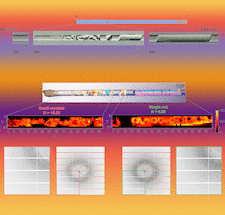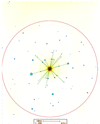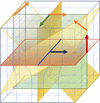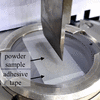issue contents
February 2025 issue

Cover illustration: De'Ath, Oliva et al. [J. Appl. Cryst. (2025), 58, 107–118] present a crystallogenesis study of human transthyretin using the counter-diffusion method as an alternative to conventional convective vapour diffusion and batch approaches for protein crystallization. This study provides valuable insights into counter-diffusion crystallization in the context of both X-ray and neutron structural studies of proteins.
editorial
Open  access
access
 access
accessThe newest eight members of the Editorial Board of Journal of Applied Crystallography are introduced.
research papers
Open  access
access
 access
accessWe have established mathematical error estimation methods for structural analysis of multi-component systems by contrast-variation small-angle neutron scattering. Our methods can be used to optimize the selection of scattering contrasts to minimize error propagation.
Open  access
access
 access
accessThis study analyses thermal diffuse scattering in X-ray powder patterns using a combined Rietveld and correlated displacement model approach applied to Ag2O in reciprocal space.
The impact of sample thickness and experimental noise on angular correlation analysis from scanning electron nanobeam diffraction patterns of disordered carbon is investigated and analyzed regarding the interpretability of the analysis results.
By applying the new technique of extended-range high-energy-resolution fluorescence detection (XR-HERFD), developed from high-resolution resonant inelastic X-ray scattering and HERFD, the analysis of data from all three techniques is explained, with solid manganese as an example. This approach allows the discovery of new physical processes in matter.
A depth-dependent investigation of the principal stress gradients in a sputtered coating is described, applying asymmetric diffraction and different data evaluation routines.
Open  access
access
 access
accessA new method of diffraction microradiography of single crystals is proposed with the aim of increasing the resolution of X-ray topographic patterns. For the implementation of this method, a device for synchronous scanning of the slit for transmitting separate parts of the X-ray diffraction pattern and the X-ray film with a predetermined speed ratio is designed, created and tested.
Open  access
access
 access
accessThe performance of a high-Z photon-counting detector for powder diffraction measurements at high (>50 keV) energies is characterized, and the appropriate corrections are described in order to obtain data of higher quality than has previously been obtained from 2D detectors in these energy ranges.
ASUGNN leverages powder X-ray diffraction patterns and symmetry constraints to enhance the ability of graph neural networks to capture crystal properties.
Open  access
access
 access
accessIntensity correction factors for grazing-incidence X-ray diffraction are derived theoretically and applied to experimental data from thin-film samples with different textures. The provided corrections promise improved quality of crystal structure solutions from thin films and allow quantitative texture and phase analysis.
Open  access
access
 access
accessX-ray and neutron diffraction studies of human transthyretin crystallized using the non-convective counter-diffusion method provide important insights into crystallization quality relevant for the growth of high-quality large-volume crystals suitable for both X-ray and neutron structural investigations.
It is demonstrated that a direct transform may be used to calculate the pair distribution functions employed in the small-angle X-ray scattering analysis of protein molecules in solution provided that the regions of the intensity curve missing from the experimental data are properly estimated. This result contradicts the frequently stated view that indirect transform methods are mandatory for reliable calculations of pair distribution functions.
Open  access
access
 access
accessThis article describes a new phase identification algorithm called poly intended for spotty selected-area electron diffraction patterns collected from polymorphic nanomaterials. We have developed this new approach to determine the predominant high-pressure phases produced in laser-shock-affected regions of silicon. Applying this algorithm allowed us to reliably identify two new t32-Si and t32*-Si phases and indicate their relaxation time in other metastable high-pressure silicon phases.
Open  access
access
 access
accessWe introduce a new signal-separation algorithm for precise background assessment and describe its application to single-crystal image compression and serial crystallography data pre-processing.
To assess the performance of a double-crystal Laue-case monochromator, this study utilizes crystal simulation which integrates two diffraction profile calculation methods, two crystal depiction approaches and twol thermal distortion treatments. The thermal assessment effectively captures interior lattice plane distortions, enabling the simulation of crystal conditions closely matching actual scenarios.
The forensic field requires versatile equipment for non-destructive characterization, analysis and inspection of 2D and 3D objects. The robotic scanner introduced here allows transmission X-ray imaging and mapping of individual photons with high-sensitivity and -resolution detectors. The broad capabilities of X-ray diffraction (XRD) imaging are now being complemented by X-ray fluorescence point analysis and mapping, multispectral macro imaging, and multispectral XRD analysis.
Open  access
access
 access
accessAtomistic models compatible with periodic boundary conditions have been employed to understand quartz–coesite interfaces.
Open  access
access
 access
accessA demonstration is given of the use of discrete and low-dimensional structure models within the periodic formalism of conventional Rietveld refinement software for the calculation of total scattering patterns.
Density functional theory calculations were used to investigate the efficacy of pure graphene, Mo-decorated graphene and Mo-decorated reduced graphene oxide in removing nitrate anion (NO3−) pollutants.
This work introduces the first direct comparison of contrast arising from dislocations using dark-field X-ray microscopy (DFXM) and the established method of transmission electron microscopy. We propose a method to directly measure the Burgers vector of a dislocation on the basis of the symmetry with which DFXM scans across a rocking curve for a given diffraction peak.
Open  access
access
 access
accessHydrostatic properties of highly inert perhalogenated fluids were investigated using ruby fluorescence measurements.
Open  access
access
 access
accessA PVT equation of state has been determined for sodium fluoride with a range of validity between 12 and 950 K in temperature and 0 and 25 GPa in pressure. This equation of state is based on a fourth-order Birch–Murnaghan expression for isothermal compression and a Mie–Grüneisen–Debye model for thermal pressure.
Open  access
access
 access
accessMicrocalcifications in breast cancer tissue have been investigated. Correlation of the occurrence of a rim of crystalline whitlockite and of a hydroxyapatite phase of high crystallinity with malignancy has been identified for the samples studied.
Open  access
access
 access
accessA novel method for precise crystal alignment in a diamond anvil cell has been developed. This method leverages Snell's law providing immediate visual feedback for alignment and offering exceptional accuracy (<0.02 mm) while being simple and fast, facilitating high-pressure diffraction experiments.
A method for calculating reciprocal-space maps has been developed, based on two-dimensional recurrence relations of X-ray diffraction in Laue geometry in a crystal with a complex elastic strain distribution.
teaching and education
Free 

By integrating fundamental crystallography concepts with hands-on experiences, our comprehensive educational strategy empowers students to master small-molecule crystallography and apply it effectively in their research.
Open  access
access
 access
accessThis work provides practical information on the conventional top dusted sample preparation method and the top dusted adhesive tape sample preparation method. For the top dusted adhesive tape method, tapes with matte acetate or polyvinyl chloride backing are recommended as they cause a comparatively low background signal without high-intensity reflections.
short communications
Open  access
access
 access
accessThe systematic error of systematically too small formal standard uncertainties of the observed intensities cannot be corrected for by the popular SHELXL-like weighting scheme. Instead, it disguises the error and induces bias in the equivalent isotropic atomic displacement parameters.
computer programs
The proposed Python library and graphical user interface (GUI) provide an open-source solution for crystal chemical analysis of both user data and published datasets. A user-friendly GUI ensures availability of the basic library features for crystallographers without programming skills, whereas more advanced use is possible for those familiar with Python.
iPowder, software for high-throughput X-ray diffraction analysis, automates tasks like indexing and unit-cell refinement, streamlining the data processing workflow and enhancing efficiency in materials science research.

 journal menu
journal menu

















































